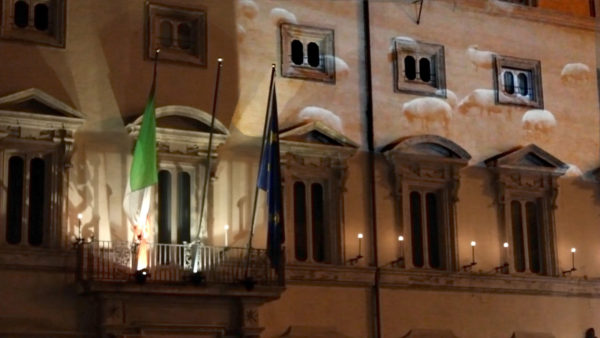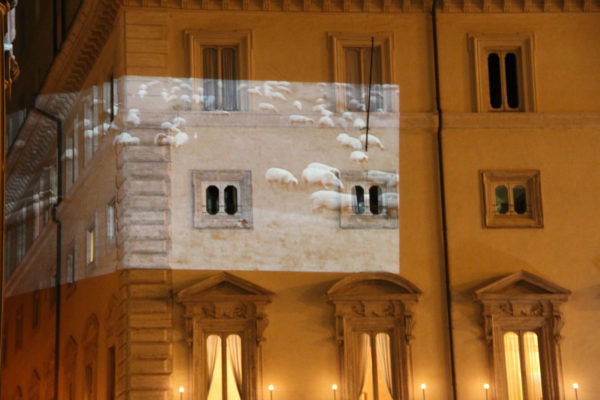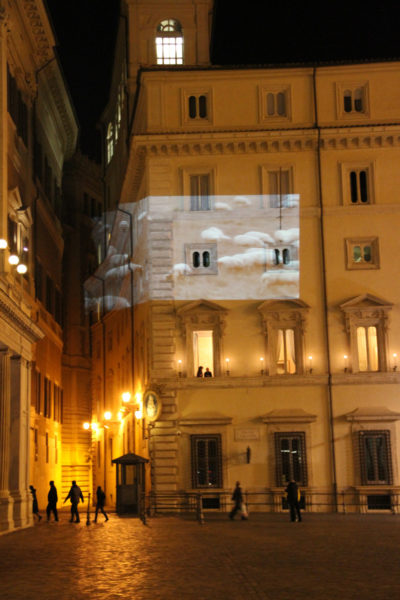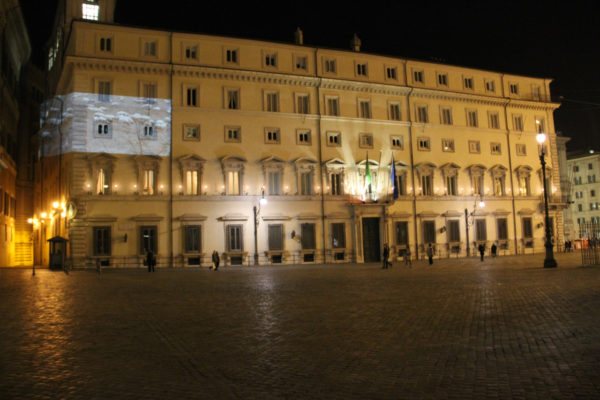Pastore a Montecitorio
Video-proiezione su Palazzo Chigi e intervento audio
Roma, 11 dicembre 2010, piazza Colonna, ore 21.00
Dopo “Lavami”, la proiezione luminosa apparsa poche settimane fa sulla cupola di S.Pietro, Iginio De Luca colpisce ancora. Questa volta con un tono diverso, più da neopaesaggista barocco che da “graffitista”, De Luca continua comunque ad incidere i suoi segni virtuali sulla città, animato da passione civile e politica. Ora è palazzo Chigi, sede del governo, che viene utilizzato come grande schermo sul quale proiettare le immagini di un gregge ripreso dal vivo, mentre intorno tutta la piazza Montecitorio si trasforma in un’installazione sonora riempita dalla voce di un pastore che richiama il gregge. “Pastore a Montecitorio” è il titolo di questa ultima azione visiva e sonora che nonostante la velocità dell’incursione da Street art, trasformerà uno dei luoghi istituzionali più importanti d’Italia, in un lento paesaggio visionario a grandezza naturale, richiamando in parte anche le origini remote del luogo. Il palazzo limitrofo progettato da Bernini è infatti un capolavoro architettonico che dissimula nella decorazione elementi naturali, rocce e rami spezzati e nell’insieme si adegua all’andamento curvilineo del piccolo “monte” che ha dato il nome al sito, come fosse un’altura di uno dei tanti paesaggi pastorali di fantasia del Seicento. Il gregge, la voce del pastore richiamano un tempo lontano, arcaico ed arcadico che trasforma il palazzo in uno schermo liquido ma, come ci ha abituati De Luca, anche questa
volta il suo intervento pubblico funziona quasi come fosse un “articolo di fondo” su un quotidiano. Puntuale, infatti, l’artista utilizza il palazzo del governo mentre quello della camera è chiuso, in attesa del fatidico 14 dicembre, giorno in cui verrà votata la fiducia al governo. In questa attesa l’autore inscena uno stallo che è un intervallo politico, da molti denunciato come la fase di compravendita dei voti: una vacanza di vera politica, quindi, che De Luca denuncia come grave assenza. La voce ancestrale del pastore è il cuore dell’evento che scuote una situazione di stallo generale, politico e sociale: un segnale forte di altri tempi, un suono umano ma anche selvaggio che non è fatto di parole comprensibili ma di energia sonora, sintomo di un umore che cova, di una direzione necessaria da prendere, di un progetto da affrontare. La proiezione in bianco e nero sulla facciata contribuisce ad innescare una serie di metafore: lo storico intervallo televisivo tra una trasmissione e l’altra, che è immediatamente richiamato, trasforma palazzo Chigi in un grande schermo TV che trasmette un programma che non c’è, tanto l’intervallo sta ad indicare l’assenza di trasmissione, il punto morto tra un prima che non c’è più ed un dopo che deve ancora venire. In questo tempo inerte le pecore pascolano abbandonate a se stesse: è il tempo appunto del mercato del voto. Come un “articolo di fondo”, appunto, il messaggio è chiaro nonostante l’uso metaforico di immagini e suoni che vengono da lontano ma il suo scopo ovviamente non è solo la trasmissione di un messaggio bensì reinventare un linguaggio in grado di raccontare il presente. Così De Luca traduce un pensiero in un evento da percepire sensibilmente prima ancora che razionalmente e aggiunge un elemento ulteriore al suo percorso che è la forza evocativa dei luoghi – usati come readymade ambientali – colti velocemente nell’attimo in cui essi stessi sono in grado, se aiutati, di visualizzare una situazione che ci riguarda tutti.
Franco Speroni
“The Shepherd at Montecitorio”
Video projection on Palazzo Chigi and audio intervention
Rome, December 11, 2010, Piazza Colonna, 9:00 PM
After “Lavami,” the luminous projection that appeared a few weeks ago on the dome of St. Peter’s, Iginio De Luca strikes again. This time with a different tone, more akin to neo-Baroque landscape art than “graffiti,” De Luca nevertheless continues to make his virtual marks on the city, animated by civic and political passion. Now it is Palazzo Chigi, the seat of the government, that is used as a large screen on which to project live images of a flock, while the entire Piazza Montecitorio transforms into a sound installation filled with the voice of a shepherd calling the flock. “The Shepherd at Montecitorio” is the title of this latest visual and auditory action that, despite the speed of the Street art incursion, will transform one of Italy’s most important institutional locations into a slow, life-sized visionary landscape, partly recalling the remote origins of the site. The adjacent palace designed by Bernini is indeed an architectural masterpiece that conceals natural elements in its decoration, rocks and broken branches, and as a whole, it adapts to the curvilinear layout of the small “mount” that gave the site its name, as if it were a hill in one of the many imaginary pastoral landscapes of the seventeenth century. The flock, the shepherd’s voice evoke a distant, archaic, and Arcadian time that transforms the palace into a liquid screen, but, as De Luca has accustomed us, even this time his public intervention functions almost like an “editorial” in a newspaper. Timely, in fact, the artist uses the government palace while that of the chamber is closed, awaiting the fateful December 14, the day when the government’s confidence will be voted on. In this waiting period, the author stages a stalemate that is a political interval, denounced by many as the phase of vote buying and selling: a true political vacation, therefore, which De Luca denounces as a serious absence. The ancestral voice of the shepherd is the heart of the event that shakes a situation of general stalemate, political and social: a strong signal from another time, a human but also wild sound that is not made of understandable words but of sound energy, a symptom of a smoldering mood, of a necessary direction to take, of a project to face. The black-and-white projection on the facade contributes to triggering a series of metaphors: the historic television interval between one program and another, which is immediately recalled, transforms Palazzo Chigi into a large TV screen that broadcasts a program that does not exist, as the interval indicates the absence of transmission, the deadlock between a past that no longer exists and a future that has yet to come. In this inert time, the sheep graze abandoned to themselves: it is indeed the time of vote trading. Like an “editorial,” in fact, the message is clear despite the metaphorical use of images and sounds that come from afar, but its purpose is not only to convey a message but also to reinvent a language capable of telling the present. Thus De Luca translates a thought into an event to be felt sensitively before it is understood rationally and adds another element to his path, which is the evocative power of places – used as environmental readymades – quickly captured in the moment when they themselves are able, if helped, to visualize a situation that concerns us all.



